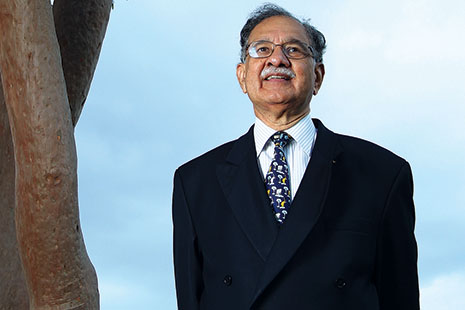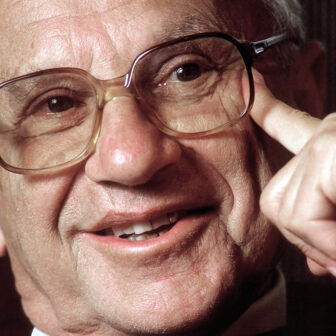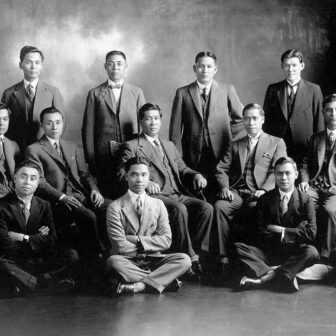IN 1961 a young graduate of Bombay University arrived in Sydney to take up a temporary position as the New India Assurance company’s representative in Australia. The White Australia policy was in force, so he had no expectation of staying for long, let alone settling for life. When he decided he wanted to change careers and work in information technology, he was told he could stay for another seven years – but on the understanding that this would be the one and only extension. By this time he was living in Adelaide, where he was one of only twenty-seven residents from India.
Fifty-two years later, Neville Roach AO can look back on a successful career as chief executive and chair of Fujitsu Australia and an impressive record of public service and civic engagement. The list of his appointments includes periods as chair of the National Multicultural Advisory Council, as deputy chair of SBS and as a member of the federal government’s Cooperative Research Centres committee.
Roach’s arrival in Australia was one of the early signs that White Australia was unsustainable and sweeping change was inevitable. But his own impact on immigration policy goes much deeper. In 1995, just before John Howard became prime minister, he helped to set off another monumental policy change – a shift that contributed to a steep rise in temporary migration and is still working its way through the political system.
With this year’s federal election looming, debate about temporary migration has focused almost entirely on the skilled work visa known as the 457, and has generally looked at the issue from either of two perspectives. The first focuses on what happens to the workers on 457 visas – their treatment by employers, and their pay and conditions. The second focuses on the impact these temporary migrants have on the labour market, and particularly whether they displace local workers and erode wages and conditions across whole industries.
Looking at the 457 visa in either of these ways certainly throws important issues into sharp relief. But there are broader issues to be considered, too – questions that arise from the fact that the 457 visa is just part of a much larger change in the migration program. What does it mean, for example, if a segment of Australia’s population – made up of temporary migrants – has only a tenuous sense of belonging, limited access to important parts of the welfare system and a sense that they are not represented in the political system? These issues have received little attention, yet they might turn out to be the most difficult of all.
FIRST, though, it’s important to understand the history behind this shift in migration – which is where Neville Roach comes in. The 457 visa was introduced soon after John Howard came to office in 1996, but had its origins in an inquiry commissioned by Paul Keating when he was prime minister. Neville Roach chaired the committee – the Committee of Inquiry into the Temporary Entry of Business People and Highly Skilled Specialists, to give its full title – and its 1995 report became known as the Roach Report.
Reading the report today highlights the extent to which the 457 program has outgrown its origins. Roach’s committee was primarily concerned with smoothing the process of “intra-company transfers” – making it quicker and easier for international corporations to bring senior executives and technical specialists into the country – at a time when the Australian economy was being opened up and two-way flows of skilled labour were growing. The Roach Report warned that other countries could retaliate against Australia’s “overly restrictive” temporary entry rules, and that could stop Australians from working overseas.
Australia was in a period of major economic change, with manufacturing declining and services growing. In a world where “trade in services is based on different countries developing specialised skills in different areas,” Roach argued that it was “not realistic for Australia to attempt to develop specialised skills in all areas.” Keating and his predecessor, Bob Hawke, had also been working to link Australia more closely with its near neighbours, and Roach hoped a revamped visa system would foster “greater integration into the international business environment – in particular the Asia Pacific region.”
From today’s perspective, though, what is most striking about the Roach Report is its attempt to ring-fence temporary business migration. According to Roach, the new arrangements were “not meant to apply to the traditional skilled trades or to professions like nursing and teaching.” Yet today, about one-in-every-five 457 visa holders has a trade qualification and nurses are one of the biggest professional groups recruited under the scheme. (Teachers on 457 visas are less common, but university lecturers are high on the list.)
Roach warned that temporary entry must not be seen “as an instrument for overcoming long-term labour market deficiencies.” Immigration minister Brendan O’Connor echoed that view recently when he asserted that the 457 visa program is only intended “to fill temporary skills shortages in some sectors and regions” and should be used “as a last resort.” But he was either misinformed or being disingenuous, for the 457 scheme has become something much bigger and more complex than Roach envisaged.
The evidence is clear in the growing number of 457 visa holders (shown in the chart below). If the sole function of the visa was to create breathing space for the local training system to catch up with demand, then you would expect numbers to plateau or to fluctuate with the changing mix of skills in the economy. Instead, the 457 visa has become entrenched as a small but important component of workforce planning, popular with employers not least because its flexibility enables them to respond rapidly to changing needs.
Growth in 457 visa holders in Australia, 2005–12
And this is only part of the picture. In the eighteen years since Neville Roach wrote his report, the increasing internationalisation of the Australian economy has gone hand in hand with the internationalisation of the Australian labour market and the Australian education system. Skilled workers on 457 visas are just part of a temporary workforce that includes international students, student graduates (on 485 visas), working holiday-makers, a significant group of New Zealanders, and people on bridging visas. Add up all these categories and, as the chart below shows, there are now close to one-and-a-half million temporary migrants with work rights living in Australia.
Temporary migrants in Australia by visa, 2005–12
The growth has been rapid. In 2005, temporary migrants made up less than 4 per cent of the Australian population; today the share is more than 6 per cent, and they probably account for about 10 per cent of the total labour force. Not all temporary migrants work – some are children, some are stay-at-home spouses, some study full-time – but their collective labour is now integral to Australia’s economy.
Nor do all temporary migrants stay in Australia for a long time. The average length of stay for a working holiday-maker, for instance, is eight months. But many live here for years and many of them wish to become permanent residents. In fact, temporary migration is being cemented in place as a stepping-stone to permanent migration, and an increasing share of the people who make up Australia’s permanent migration intake are already living and working here on temporary visas. This is not an incidental outgrowth of temporary migration; it is the result of deliberate policy changes that have created a two-step migration program. The 457 visa, once a temporary mechanism to fill skills gaps, is now an integral component of the selection process for permanent migration. International student visas play a similar role – not just a way to sell Australian education, they are also part of the system by which Australia chooses future workers, residents and citizens.
EVER since the 457 visa was first introduced there have been documented examples of temporary foreign workers being abused by employers. Nursing assistants from the Philippines have had large sums of money unlawfully deducted from their wages in return for training that was never provided; a Canberra chef was abducted by his boss after complaining to the immigration department about being overworked and underpaid; construction workers in Western Australia were pressured into signing undated individual workplace agreements that they had no chance to read. Earlier this month Fairfax journalists reported uncovering up to 200 examples of temporary migrant workers being ripped off, including some forced into “debt bondage.”
Depending on your point of view, such cases are either a symptom of a few bad apples among employers or they are the tip of an iceberg of exploitation. The evidence suggests, not surprisingly, that the truth lies somewhere between.
The most extensive survey of 457 workers, carried out in mid 2012, showed high levels of job satisfaction. This independent study, which gathered the views of 3812 visa holders who had been in Australia for at least ten months, was commissioned by the immigration department and analysed in a research report published by the recently formed Migration Council Australia. It showed that 88 per cent of workers on 457 visas were either “satisfied” or “very satisfied” with their relationship with their employer. There was also evidence of abuse: about 2 per cent of workers reported earning a salary of less than $40,000 per year, for instance, which is well below the minimum mandated under the scheme. It is notable, too, that when they were asked about their wages a quarter of respondents either refused to answer or said, “Don’t know.”
The most systematic investigation of the 457 scheme was undertaken in 2008 by industrial relations commissioner Barbara Deegan. She concluded that the cases of exploitation that came to official attention were “a very small part of the overall problem” because the “precariousness” of 457 visa holders made them “reluctant to make any complaint which may put their employment at risk.” This was particularly true of “visa holders at the lower end of the salary scale” – the tradespeople and other less-qualified workers who make up around a fifth of all 457 visa holders. They feared losing not only their jobs, but also their visas and their right to live and work in Australia.
Amendments to the 457 scheme introduced into parliament in June belatedly sought to address this issue. Implementing one of Deegan’s key recommendations from five years ago, they gave workers ninety days to find a new employer if they leave a job. Workers have had only twenty-eight days to find alternative employment before their 457 visa expired. (In practice, the immigration department often extended that period, but bureaucratic discretion is no replacement for a legislated right.) If temporary migrant workers know that they have more time to find another job then they can more confidently stand up to abusive bosses and resist exploitative conditions, unsafe work practices and underpayment.
Deegan identified a second aspect of the system that creates the conditions for exploitation – an employer’s power to give or withhold support for permanent residency. Over the past decade about 40 per cent of 457 visa holders have transitioned to permanent residency and, according to the departmental survey, more than 70 per cent of those in Australia now hope to do the same. In order not to jeopardise sponsorship, Deegan wrote, workers may put up with “substandard living conditions, illegal or unfair deductions from wages, and other similar forms of exploitation.”
The more the 457 visa becomes the first step in a two-stage migration process, the more the second step – employer sponsorship for permanent residency – becomes a potential lever of power in the workplace. Policy changes made last year further entrenched this power: under the temporary residence transition scheme, any 457 visa holder seeking to become permanent must work for the same employer for two years to become eligible for sponsorship. This reduces workers’ mobility in the labour market and intensifies the pressure to keep in sweet with the boss. Migration Council Australia recommends changing this rule so that a 457 visa holder can seek sponsorship for permanent residency after two years’ continuous work in Australia “irrespective of the number of employers they have worked for.”
This worthwhile reform still wouldn’t put temporary migrants on an equal footing with their Australian counterparts in the workplace. In fact, full equality is unlikely to be achieved because of the many differences that arise from temporary migrants’ visa status. They can’t rely on the safety net of government benefits if they become unemployed. The insecurity of their tenure in Australia makes it less likely that they can seek redress under unfair dismissal laws. Temporary migrants can’t vote or run for public office and have no voice in the political process. And, as the recent collapse of the cleaning company Swan Services revealed, temporary migrant workers are not covered by the Fair Entitlements Guarantee, the government scheme to ensure workers receive entitlements like missing wages, holiday pay or superannuation contributions when a company goes into receivership. The combination of these and other factors will leave temporary migrant workers more vulnerable to abuse and exploitation than their Australian counterparts simply because they are temporary.
THE Gillard government’s recent preoccupation with 457 visas focused on whether migrant workers are pushing Australians to the back of the job queue. There has been much talk of employers “rorting” the system by importing labour instead of employing locals, but little firm evidence to back up the claim.
Immigration minister Brendan O’Connor has noted sharp increases in the use of the 457 scheme in Tasmania and South Australia, despite unemployment in those states being above the national average. But such statistics must be treated with care: when overall numbers are small, percentages can jump about dramatically from month to month. The number of 457 visas issued in Tasmania might have risen by a third in the year to 30 April 2013, but this represented an increase of only eighty visas (from 240 to 320). Taking the 2011–12 financial year as a timeframe produces a quite different result – visa numbers in Tasmania fell by 4 per cent despite growing by 42 per cent Australia-wide.
The minister has also registered his concern at the rapid growth in 457 visas in the hospitality industry, particularly for cooks. In the year to 30 April 2013, “cook” was the most frequently nominated occupation for a 457 visa and visa grants to cooks almost doubled (from 1210 to 2400). Nor were all these cooks recruited for hard-to-fill jobs in remote mining camps. Victoria imported four times as many cooks as Western Australia did.
It is reasonable to question why employers are importing cooks from overseas rather than training them locally, but the answer is not as simple as the claim of “rorting” would suggest. For a start, the evidence about a shortage of cooks is contradictory: employers say that they have trouble filling positions and yet the government’s career handbook, Australian Jobs 2012, lists cooks as an occupation suffering from high rates of unemployment.
But there’s another important factor. Australia’s vocational education system seems to do a dismal job of producing qualified cooks, with the completion rate for certificates in the food industry languishing at around 30 per cent, well below the average for trades as a whole. Why is the attrition rate so high? One important factor, according to recent research, is that “the life of the apprentice cook is one of poor wages, unsociable hours and unpaid overtime.” Even after qualifying, many cooks work broken shifts in a high-pressure environment for relatively low pay. Unless wages rise, conditions improve and diners pay more in restaurants, the shortage of domestically trained cooks is likely to persist. Equally, the fact that employers can recruit offshore staff willing to accept prevailing pay and conditions helps to keep wages down. At $55,000, the average base salary for 457 visa holders in the accommodation and food services industry is by far the lowest of any sector – the next lowest are agriculture, forestry and fishing ($68,800), and retail ($69,600).
The immigration minister’s response to concerns about temporary migrants displacing Australian workers was to seek to reintroduce labour-market testing, which was part of the 457 visa scheme when it was introduced in 1996 but was dropped in 2001. Before employers fill a position with a worker on a 457 visa, they would have to demonstrate that they’ve made a serious effort to recruit local staff by advertising the position, participating in career expos or engaging a recruitment agency. Employers say this is unnecessary: because it is far easier and cheaper to recruit locally, businesses already have a strong incentive to hire Australians first whenever they can. They say there is no “cheap labour” benefit in bringing in offshore labour, since the market-based salary requirement ensures that 457 visa holders are paid at or above the rate that Australian workers receive for the same work in the same location.
Unions, though, welcomed the plan to reintroduce labour-market testing. Without it, they say, employers can’t be said to be “rorting” the system when they hire offshore workers ahead of Australians because they are under no obligation to do otherwise. The question is whether labour-market testing achieves the desired outcome; in the past, it proved cumbersome to implement and difficult to monitor, and risked devolving into little more than a bureaucratic box-ticking exercise. “An artificial process” is how one migration lawyer described it in evidence to a Senate inquiry. The Migration Council Australia report argued that a better way to encourage local recruitment is to increase the fees that a business pays to nominate (currently $85) and sponsor ($420) a worker on a 457 visa. These are rock-bottom prices. Lodging an application for a spousal visa, for instance, costs either $2680 or $3975 (depending on whether it is lodged outside or within Australia).
There are also fears that employers use the 457 visa instead of spending money training local workers. The department’s response is a training benchmark: any business using the scheme must either spend at least 1 per cent of payroll on training their existing staff or contribute 2 per cent of payroll to a recognised industry training fund. Whether these measures are sufficient to ensure that locals get trained before a 457 visa is used is debatable. In an era of relatively low unemployment, a significant number of people outside the labour market will need intensive assistance to move into any job, let alone a skilled position. (The 457 visas are limited to positions that require training to Certificate III level or above and two years of on-the-job training.) Holders of 457 visas can also be part of the solution rather than part of the problem by passing on the skills they bring to Australia. In the survey analysed by Migration Council Australia, more than three-quarters of 457 workers reported that they helped to train or develop other workers in the course of their job and more than two-thirds of employers said they used 457 visa holders to train Australian staff.
That the vocational education system could do a better job of equipping locals to meet the needs of business is beyond dispute. Whether the rise of the 457 visa system has contributed to this state of affairs is a different question. Overall, there is no simple equation between adding a foreign worker and taking an Australian job. If an employer uses a 457 visa to fill a crucial position because no local candidate has the right skills and the temporary migrant enables that enterprise to expand its operations, there will be a net increase in “Aussie” jobs in the economy. Temporary workers also generate local employment by spending money on goods and services.
THE number of temporary migrants living in Australia with work rights grows larger year by year. Along with the 190,000 skilled workers and their family members on 457 visas there are 630,000 New Zealanders, whose special category visas allow them to live and work in Australia indefinitely but don’t give them residency rights and entitlements. Then there are some 330,000 international students, 41,000 student graduates on post-study visas, 118,000 migrants on bridging visas (awaiting the outcome of an application for permanent residency, for example) and 170,000 working holiday-makers.
These numbers show little sign of declining, and in some categories are likely to increase sharply in the near future. In the case of international students, the federal government recently expanded the post-study 485 visa so that anyone completing a bachelor’s degree can work in Australia for two years after graduation. (Successful master’s and doctoral candidates qualify, respectively, for three- and four-year work visas.) The aim of the 485 visa was to give international students graduating from Australian courses a chance “to gain skilled work experience or improve their English language skills,” but it was broadened to make study at an Australian university more appealing in a competitive global education market. We can expect it to boost international enrolments further, as tens of thousands more students are drawn to the option of working in Australia after they graduate. Unlike 457 visa holders, they can take up any job in any sector, irrespective of their qualifications and chosen course of study.
Different categories of temporary migrants have different characteristics, and not all of them are here primarily to work. What they all have in common is that they pay their way in Australia, and often pay taxes as well, but have limited access to government services and no formal representation or public voice. As their numbers grow and these schemes become increasingly important paths to permanent residency, we need to think carefully about their policy and ethical implications.
Is it a good thing, for example, that funding rules prevent local councils from vaccinating the children of 457 visa holders and international students? To insist that migrants make a doctor’s appointment and pay out of their own pockets might save money in the short term but could have costly consequences for the health of individuals and communities. And should we continue to withhold English language training from the tens of thousands of spouses of 457 visa holders in Australia? While spouses – mostly women – can work, they often struggle to find a job or make personal connections, particularly if they come from a non-English-speaking background and particularly if their spouse is working long hours or in a distant location, as is often the case. Given that a significant proportion of them will go on to become permanent residents, wouldn’t it make sense to provide them with English language tuition or other support from day one?
More broadly, how long is it acceptable for a temporary migrant to live, work and pay taxes in Australia, without political representation or access to government services? There are almost 20,000 international students paying fees to study at Australian primary and secondary schools. Some are the children of 457 visa holders or other temporary migrants; others are senior high school students sent to Australia to complete years 11 and 12 while living with relatives or in home stays. Most will go on to study at Australian universities. By the time they graduate from an undergraduate course they will have lived in Australia for five years or more; if they spend two more years working on a post-study 485 visa then they will have been here for at least seven years. That is a fair proportion of a young life, especially when it encompasses the years of transition to adulthood. By that time they may well talk, act and feel like Australians.
A young graduate from China told me recently that after five years in Australia, she thinks differently and her values have changed. She says she found both her faith and her friends in Australia and finds it difficult to contemplate returning “home” because Australia now feels more like home than China. Yet she may never find a permanent place here because the number of temporary migrants with aspirations for residency outstrips the number of places available in the permanent migration program. This imbalance is likely to grow over time, and to involve a growing number of migrants living in Australia for longer periods without being able to settle psychologically, socially and culturally. This will produce anger, frustration and disaffection.
The response may be – so what? This is a contract freely entered into. Temporary migrants come here to study or work with no promise that permanent residency will ever be part of the deal. But migration – even temporary migration – is always more than a mere economic transaction. The longer a migrant stays in a country, the more the contractual nature of the arrangement recedes into the background and the sense of attachment to and engagement with the host country grows. We are social beings. We live together in communities, and our society and culture are shaped by our interactions. We establish bonds of connection, interdependence and mutuality. Out of those bonds grows an ethic of reciprocity and obligation. That ethic will eventually make its presence felt, no matter how hard we seek to ignore it.
Few would have recognised it at the time, but the arrival of a young Neville Roach in Australia more than fifty years ago was a sign that major change was on the way. The increasing presence of temporary migrants today may presage a similar transformation of Australia as a nation. •




